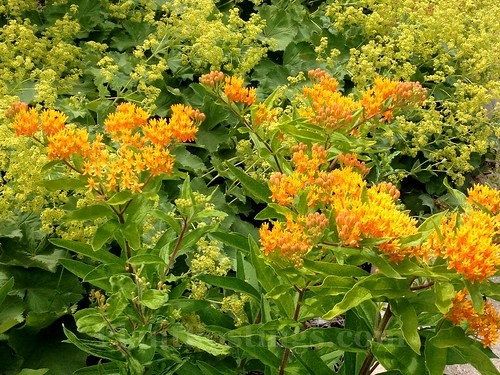
How can a gardener dislike Butterfly Weed (Asclepias tuberosa)? In my mind, "weed" doesn't even belong in the name (of course, that can be said of many plants, under various conditions).
As I considered which plant to highlight this month, and as an entry in Gail's Wildflower Wednesday meme, I chose this one--even though it's not blooming in my garden currently. In fact, it hasn't even emerged from the soil yet. (Smart plant: We'll have three nights with freezing temperatures this week, after two full weeks without a freeze.)

I chose this plant for its merit as a lovely garden focus and because it's a Milkweed (Asclepias)--the grouping, or genus, of plants that serve as host plants (food) for Monarch caterpillars. As you consider which new perennials to add to your garden this spring, consider Butterfly Weed.
This plant can take time to establish, but once it does, I think you'll be pleased.
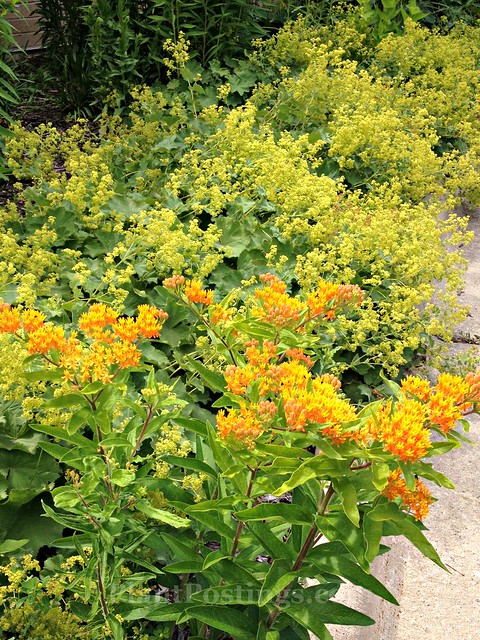
It's stunning planted among other garden blooms, as shown here with Lady's Mantle (Alchemilla mollis). I also enjoy it alongside purple and blue flowers and foliage--complementary colors to its bright orange.
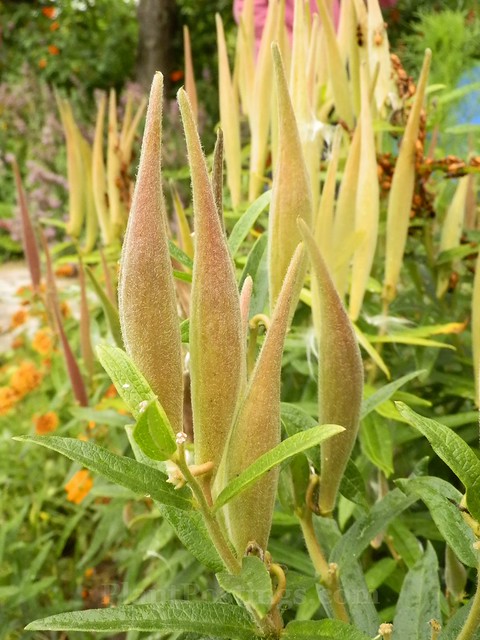
Even the seed pods that form in the fall are graceful, soft, and colorful.
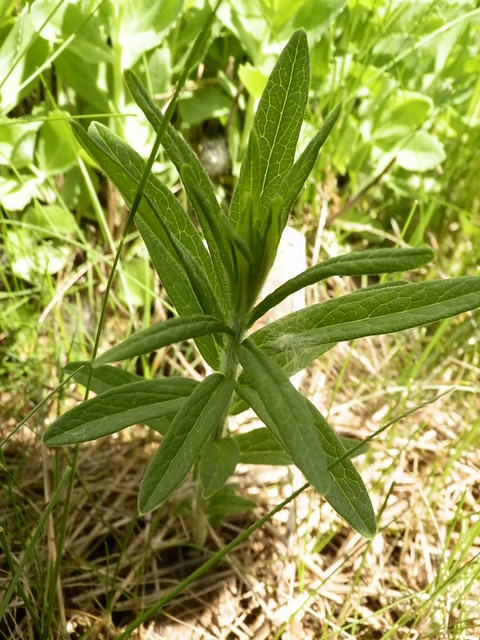
I started my own patch with seedlings purchased from a local garden center.
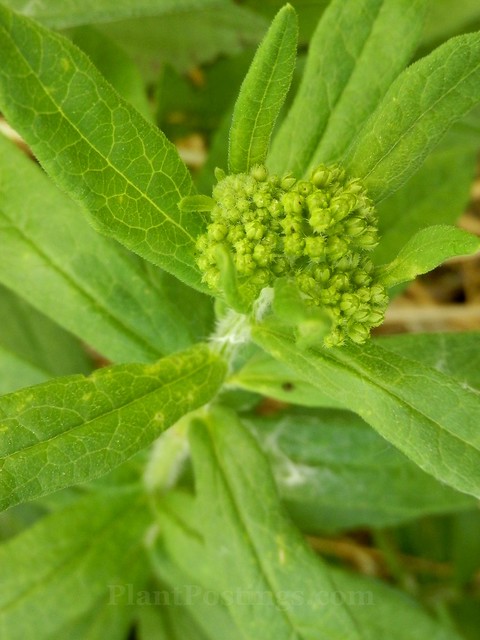
They bloomed the first year. If you start this plant from seed, expect blooms after a few years. Butterfly Weed has a long taproot, so it doesn't like to be moved. Also, consider planting several seedlings together, so the caterpillars have plenty to eat.

Don't be surprised if your plants look a little ratty at first. That can mean the Monarch caterpillars are eating them (yay!) and/or that the plants are settling into your garden, which can take a little time.
Here are a few basic characteristics, as described by the North American Butterfly Association and the Lady Bird Johnson Wildflower Center:
- USDA hardiness zones: 3 to 9
- Bloom period: mid- to late summer
- Height: 12 to 36 inches
- Spread: 24 to 36 inches
- Light exposure: sun
- Soil moisture: average to dry
- Native range: much of North America (see links for specifics)
- Attracts: butterflies, hummingbirds, other pollinators
- Resistant to: deer, rabbits
- Larval host to: Grey Hairstreak, Monarch, and Queen butterflies
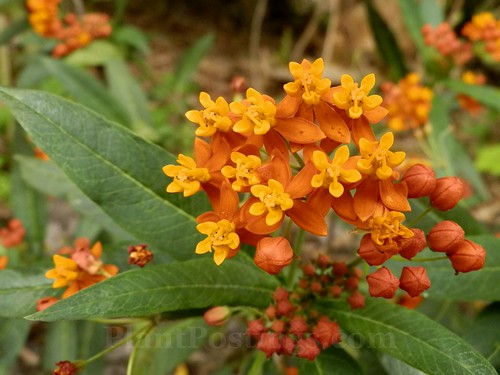 |
| Tropical Milkweed (A. curassavica) |
Butterfly Weed tends to be orange in color, but ranges from bright yellow to deep orange. It can be confused with Tropical Milkweed (A. curassavica), which has similar coloring, but isn't native in the U.S. and Canada.
Much discussion has centered around the pros and cons of planting Tropical Milkweed: To read about it, click here. Tropical Milkweed isn't a problem in northern gardens. But Butterfly Weed is just as beautiful, and its native range extends through much of North America. Plus, it survives drought and severe winters. In my northern climate, Tropical Milkweed dies back and must be repurchased each year, while Butterfly Weed simply goes dormant and re-emerges year after year. To me, it's a no-brainer to go with the native species. (Here's a link to find other native Milkweeds for North American gardens.)
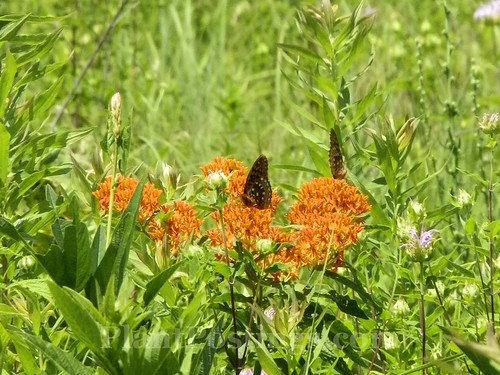
Oh, and the name is right: It does attract butterflies--Monarchs, and many others (including Great-Spangled Fritillaries).
* * * * * * * * * * *
(Congratulations to Ricki at Sprig to Twig for winning the drawing for the homemade oriole feeder!)
A beauty! and that's a neat photo of the pods ... very nicely "arranged"
ReplyDeleteYes, love it. Thanks--I haven't had seed pods on mine yet during the few years I've had A. tuberosa, but it comes back every year. The seed pod photo was taken at a botanical garden. My Swamp Milkweed and Whorled Milkweed are prolific with seeds, though.
DeleteI like your pod pic too. Last year mine made so many pods that exploded, I am a bit worried how many will be in the garden. I should have cut the off when immature.
ReplyDeleteThanks, Donna. I was taken with how pretty they were in the setting. I hope my A. tuberosa plants will produce seeds this year. My other Milkweeds have produced seeds, but I'm thinking the Buttefly Weed needs to "settle in" before it proliferates.
DeleteGreat photos, especially like the pods. I've been adding A. tuberosa over time as I phase out the tropical milkweed. The monarchs definitely prefer the tropical when both are available. The monarchs are here now, hope they stay a while and keep out of the cold!
ReplyDeleteThanks, Shirley. I've noticed many botanical gardens even here in the north use Tropical Milkweed, too. It is very pretty, but so is the Butterfly Weed. I noticed the Monarchs were going crazy for the Tropical Milkweed in Florida. Yes, I hope the Monarchs will stay south for now, too. It's crazy cold up here right now. Ick. Hopefully, it will pass quickly.
DeleteNice pictures of a wonderful plant.
ReplyDeleteThank you, Dorothy! Yes, it's a beauty. I've planted mine near some other Milkweeds and nectar plants. I keep adding more each year, and I'm seeing more and more butterflies. :)
DeleteI'm going to add this to my garden this year! You chose a great plant to feature. My favorite is the dried seed pods in the fall when they open and the silky seed parachutes are revealed.
ReplyDeleteThanks and yay! Yes, I enjoy seeing the seed pods, too. I haven't had any of my A. tuberosas go to seed yet, but other Asclepias species have, and they are fun to see and harvest. I cut mine off just before they disperse into the neighborhood. Then I plant them where I want more Milkweeds and give them away. :)
DeleteGreat post, Beth. I have a new one in my garden, along with the A.curassavica, and I hope, more on the way from monarchwatch.org. Yours are beautiful and so appropriate for a gardener to plant and foster. All your photos are beautiful, but I especially love the pods!
ReplyDeleteThanks, Tina. I have an area in my garden where nothing else seems to want to grow, so I'm going to try to get some shade-tolerating, drought-tolerant native Milkweeds going there. It just hit me last year that it makes sense. The pods are nifty, aren't they?
DeleteHi
ReplyDeleteI am going to add this to my garden. The work has started on our new basement wall. One area of my garden is going to get a bit of damage. So I will get to re do! :)
I love the pod photo.
Hi Carla: Great! It sounds like a very fun project, indeed! I hope I'll get some seed pods on my Butterfly Weed this year. My other Milkweeds produced seeds quickly, but the A. tuberosa, though it bloomed quickly, is taking its time to produce seeds. I love the seed pods on this one!
DeleteOh! How gorgeous it is. I've never seen this butterfly bush. I've only known of the very large purple one that has long flower shapes like lilacs. I wonder if they are in the same family though. I love it that you get so close to the insides of things. Beautiful work. Hoping you are well and loving your Springtime!
ReplyDeleteHi Susie: This is Butterfly Weed (Asclepias tuberosa). I think you're referring to Butterfly Bush (Buddleja davidii), which is not a host plant for Monarchs, but the adult butterflies love it for its nectar. Both are gorgeous plants, though! Thank you for your very kind comments. :) Happy spring!
DeleteI think that the effort gardeners over there are going to to provide for the Monarchs is an extremely important one Beth.
ReplyDeleteHope all your plants/seedlings do well and encourage even more creatures into your garden.
Hi Angie: I hope enough gardeners, volunteers, and organizations will rally round to save the Monarchs. It sure seems like a noble cause to me. They are such regal insects. Plus, by providing excellent habitat for Monarchs, we can also help other wildlife that have lost some ground. Thanks for your well-wishes. :)
Deleteit has such an exotic colour - the colour of Monarch wings in fact. Wish it was a native here
ReplyDeletep.s. trans-seasonal times - when the seasons jostle with each other until one finally wins out. Hope your frosts recede for good soon
Yes, it's quite bright. Very pretty in the wild, and a gorgeous addition to a more "organized" garden. Yes, we're trying to leave the frosts behind us now. Looks like this week will be frost-free. Yay! Hope your days ahead are pleasant and warm, too!
DeleteDear Beth, thanks for featuring Butterfly Weed and inspiring people to feed the butterflies! I love, love, love the combination of Butterfly Weed and Lady's Mantle so pretty! Thanks for posting the link to find other native milkweeds to Northern America I am off to check it out!
ReplyDeleteWarm regards,
Christina
Hi Christina: You're most welcome. I started thinking about Butterfly Weed, and thought "yes, that would be a good choice for this month as we're all planning what to add to our gardens." I'm planning to add more Milkweeds to my garden, too. I hope I'll have many Monarch visitors and caterpillars this year. :)
DeleteOne of my absolute favorites! An all around winner for color, habit, toughness, and of course wildlife benefit. I'm adding some more this spring!
ReplyDeleteThat's great, Jason! I really like it in combination with other native wildflowers--and I know you have a great collection!
DeleteI felt all righteous when I bought milkweed at a native plant sale. Turns out, it blooms a pale, dirty sort of pink. Then I bought one in bloom that had a fab bright red and orange flower, only to learn it is a non-native and thereby (according to some) a no no. Now I'm going to be on the lookout for Asclepias tuberosa. I guess there is always a third path, if you look hard enough.
ReplyDeletericki, I wonder if the pale pink blooming one was a swamp milkweed. That's still a good monarch and pollinator plant, so I hope you learn to like it OK if that's what it is.
DeleteHi Ricki: I'm not sure Tropical Milkweed would be a problem for you in Portland? Maybe it would be a problem--because you don't have freezes very often, do you? You could probably grow it and then cut it back to the ground in the fall? I also found this report from the Xerces Society that lists native Milkweeds in Oregon: Oregon Milkweed List. Good luck!
DeleteIt's nice to see someone else who appreciates Butterfly weed! I have three lovely batches of it that I grew from seeds.
ReplyDeleteThat's great! I think I might try to grow more from seed. So far, the plants I've added to my garden have flowered but didn't produce seed. I saw pollinators on them, so I would have thought they would have produced seeds, but maybe they dedicated their energy to the taproots and the plants. I have gotten seedpods from my other Milkweeds, though.
DeleteAlways love seeing this on my summer walks, and I love the tropical one you shared.
ReplyDeleteI love the Tropical Milkweed, too. I noticed they planted it at a new wildflower garden near my parents' place in Florida. I'm not sure it's a problem down there--especially if they trim back the plants in the fall/winter. Monarchs can survive there all winter, but I guess it's good to minimize the plants for part of the year to avoid that nasty virus the butterflies can get.
DeleteThank you for highlighting this plant. I love them in my front garden... Michelle
ReplyDeleteMichelle: I'll look forward to photos of your front garden this summer. It must be lovely with patches of Butterfly Weed!
DeleteWhat a wonderful plant and good for Butterflies as well, beautiful colour.
ReplyDeleteAmanda xx
Yes, it's great--both in the wild and in the garden. Love to see the butterflies on it!
DeleteI have some milkweed seed. I find the flowers uniquely beautiful!
ReplyDeleteI agree, Diana. Some I enjoy more than others. This one, and Rose (Swamp) Milkweed are my favorites. :)
DeleteA perfect choice Beth....I love seeing this grow and move around the garden. The seedpods are a favorite of mine. There is a whole huge patch of this growing along the Interstate...they cut it back early and I am hoping it doesn't diminish the plant this year. I love seeing the orange blooms stretch on and on.
ReplyDeleteI haven't had this one go to seed yet. My other Milkweeds have, but this one seems to be taking its time. I hope I get some seedpods this year. For all my Milkweeds, I harvest the seeds before they scatter around the neighborhood. I give some away and plant some back in my garden. I agree--I love seeing the orange blooms stretch on and on. :)
DeleteI love Asclepias tuberosa! I love orange flowers (orange being my husband's favorite color), and, of course, they are great for the monarchs. I planted started some seed one year very early, and I was quite pleased and surprised when they bloomed the first year. (That was down in North Carolina, though, so they had a nice long growing season.) I have a good amount of Rose Milkweed in my current garden, but none of the orange tuberosa. Sadly, I have yet to see any monarchs on them.
ReplyDeleteHi Indie: I've seen Monarchs on both, but my Butterfly Weed is on the side of the house without a window, so I don't see that part as often. The Rose Milkweed definitely attracts Monarchs, Giant Swallowtails, Hummingbirds, and other pollinators. And I can see that patch from my windows toward the backyard. It's wonderful to watch them all enjoying the plants. :)
DeleteI have tried to grow this a couple of times, unsuccessfully. Perhaps it would be happier in another spot. I have Baptisia growing in a sunny spot with its indigo blue flowers, and Asclepias would be wonderful with it. Should I try a third time?
ReplyDeleteHi Deb: I thought my Butterfly Weeds were dead, and then they came back. I've heard this plant can be hard to get going, but then it performs well after that because it has such a deep taproot. I suppose that's why it's drought-tolerant. I wonder if starting them from seed might work better? I think I'm going to try that, myself. :)
DeleteHi Beth, I enjoyed your post. I have never grown any milkweed from seeds, and am thankful to have found several different kinds of milkweed, and that common milkweed grew here on its own. I have several butterfly milkweeds, and am happy to see all of them joining in on spring this week by poking up out of the ground.
ReplyDeleteThanks, Sue. Yay! I'm glad yours are poking up and getting ready for the Monarchs! None of mine have made an appearance yet, but it looks like tonight will be the last frost for a good long time (maybe until fall?). That should help them to get going. :)
DeleteReally looks great with the Alchemilla. I have swamp milkweek in my bog which has pink flowers.
ReplyDeleteI like the Butterfly Weed with the Lady's Mantle, too. Swamp Milkweed (A. incarnata) is my all-time favorite Milkweed. It attracts so many pollinators, including Monarchs, Giant Swallowtails, other butterflies, and hummingbirds. I thought I had featured it as a plant of the month. But I looked back, and I haven't! So, I'll have to feature it one of these days. Apparently, Monarchs prefer it for egg-laying.
DeleteThis is one of my favorite summer plants. I'm always finding new spots where I can stick a few more clumps. My plants are just starting to come up. Even the whorled milkweed you gave me is coming up! Yay!
ReplyDeleteI want to add more, too. It's such a bright ray of sunshine! Yay--glad to hear the Whorled Milkweed is emerging for you. Mine is, too. The others are slower, but the Whorled in a pot is making an appearance. It seems like such a tender plant, but it's amazingly sturdy. Enjoy!
DeleteSorry I almost missed these beauties!!!
ReplyDeleteYou didn't miss them. ;-)
DeleteHi Beth, what a perfect plant to choose. Indigenous, perennial, and provides food and habitat for caterpillars and butterflies. I've planted some indigenous plants that are supposed to be butterfly magnets, Sweet Bursaria, but they haven't flowered yet. I agree - the seedheads are lovely.
ReplyDeleteYes, I want more of it, Sue. I've noticed more people singing its praises lately, too. It's not the preferred food for Monarchs, but every Milkweed plant helps. Sweet Bursaria--I will look it up ... not because I would plant it here, but just because I'm curious. Then, if I ever visit Australia, I'll be familiar with it. ;-)
Delete